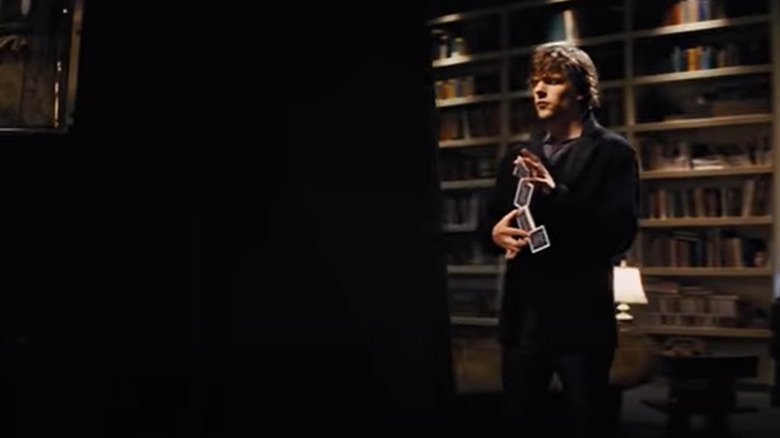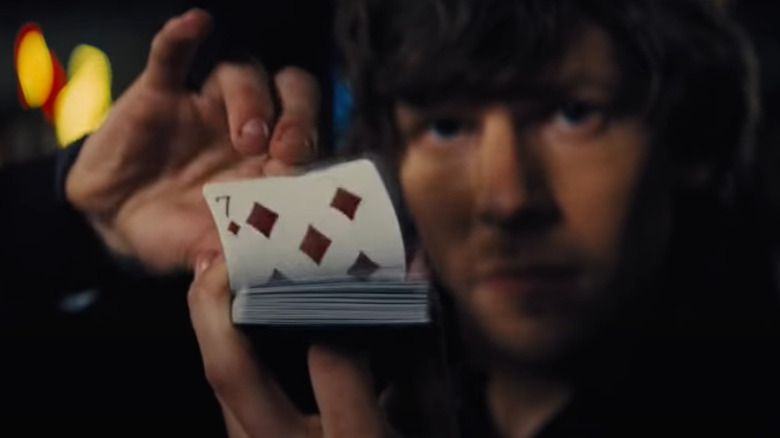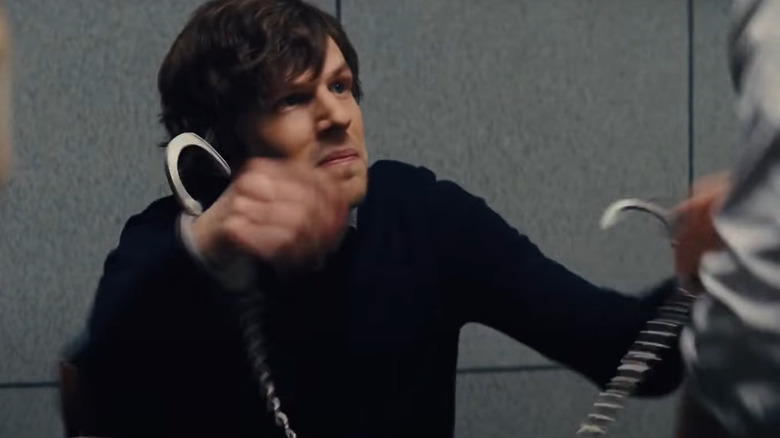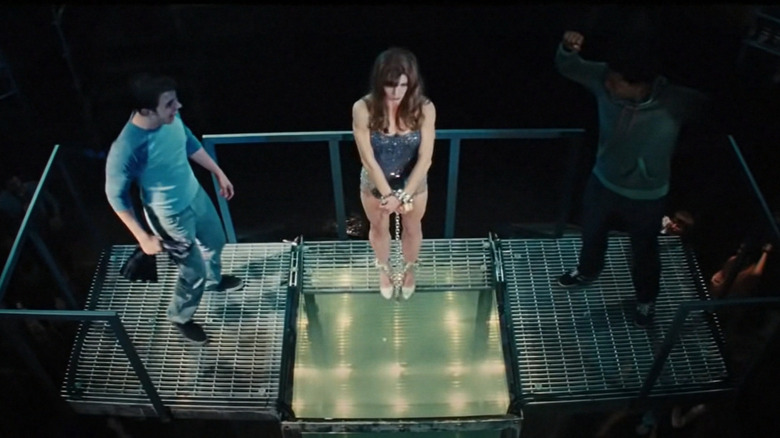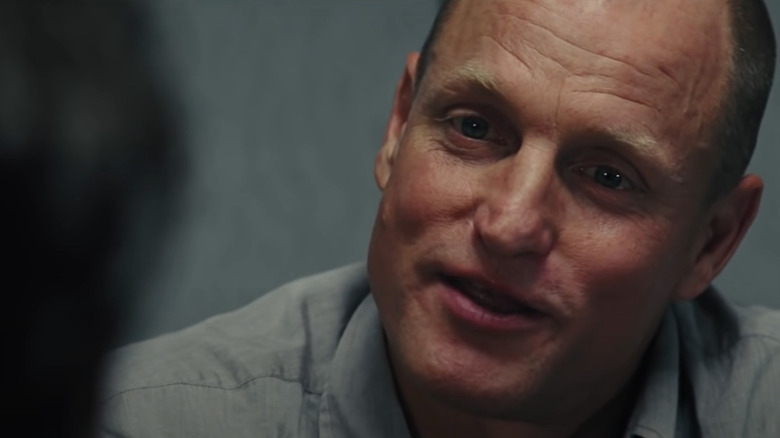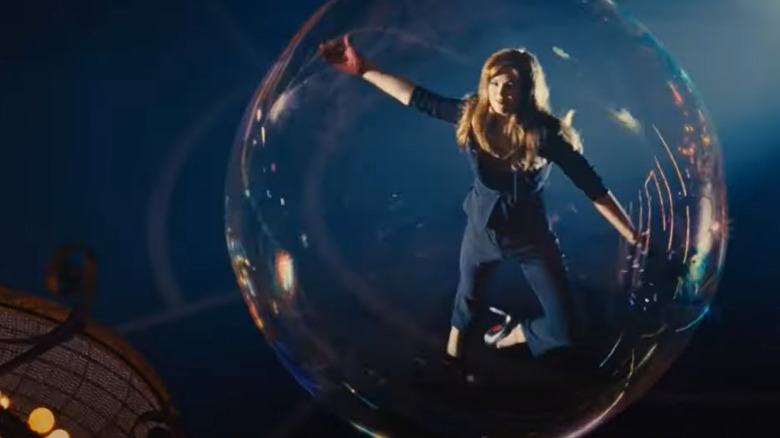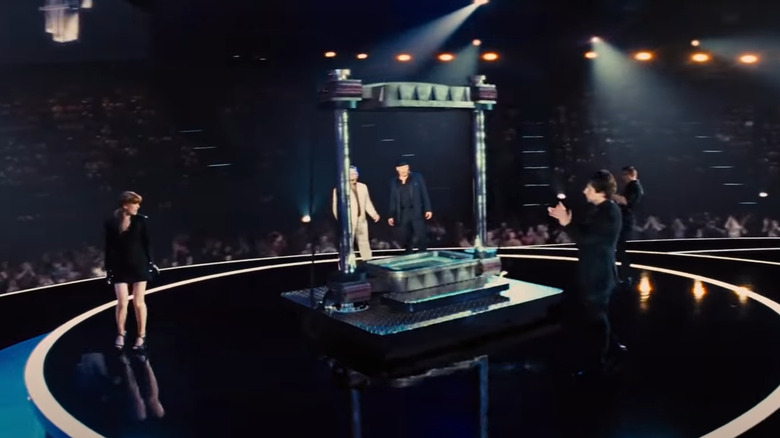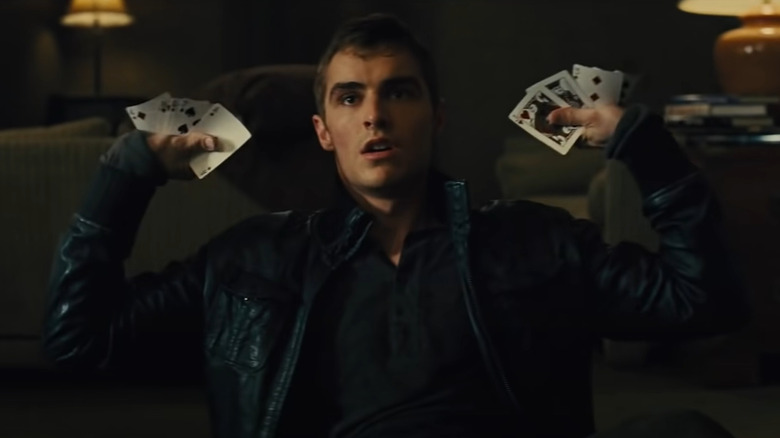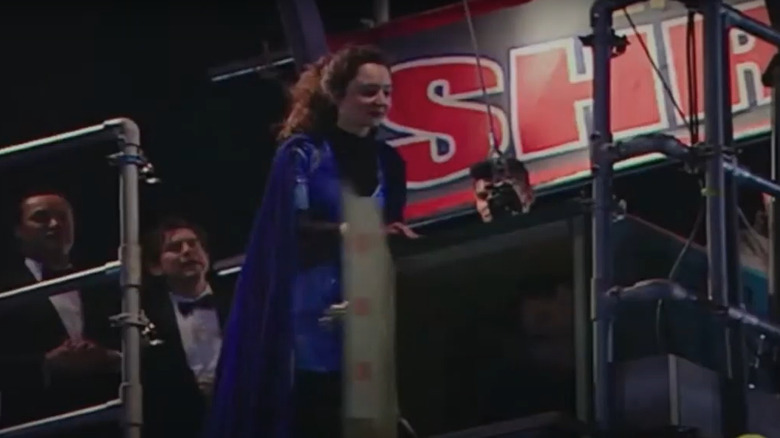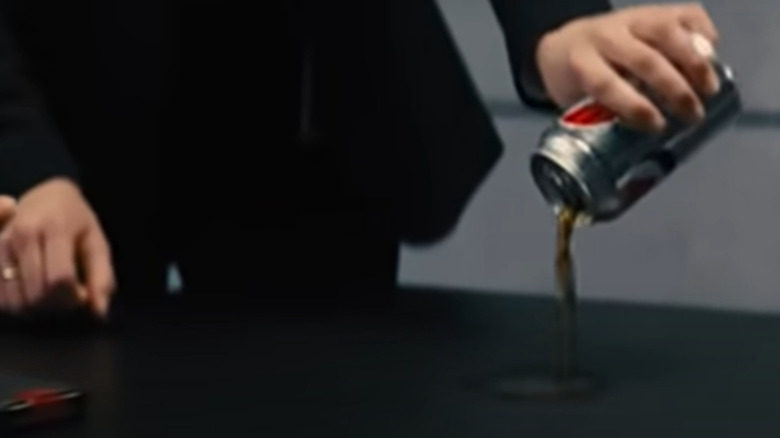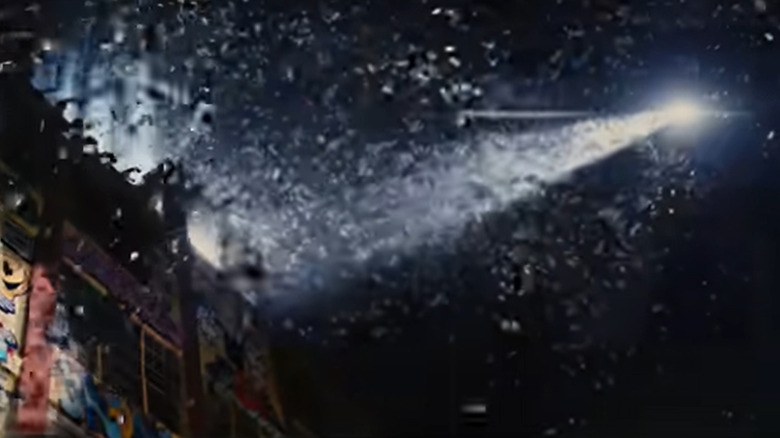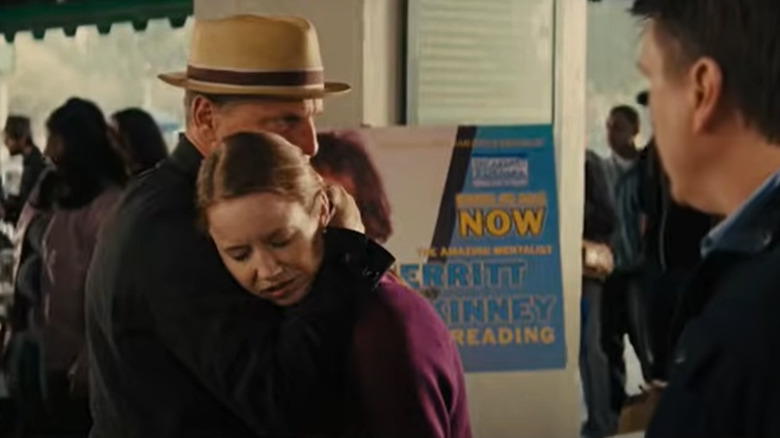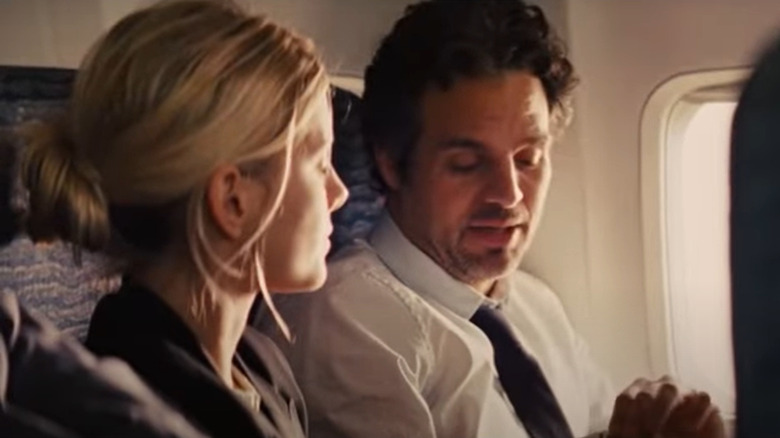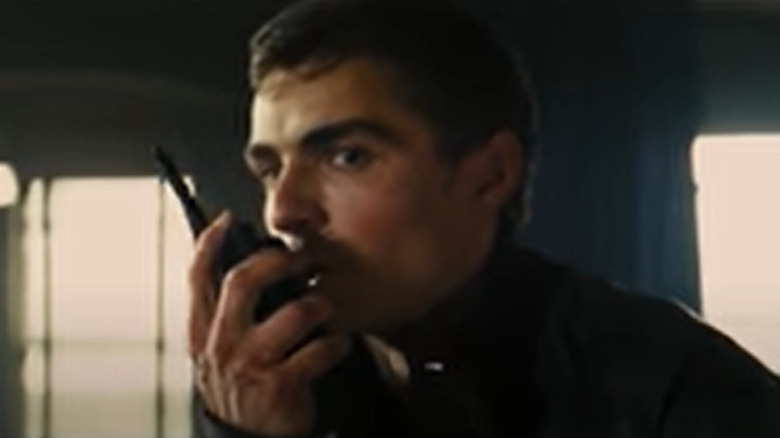The Magic Tricks In Now You See Me Explained
2013's "Now You See Me" followed a group of street magicians and illusionists recruited by a mysterious organization known simply as the "Eye." On the orders of the organization, the illusionists dub themselves "The Four Horsemen" and embark on a series of escapades to steal money from right under the nose of a corrupt company and give it back to the people. On the trail of the Horsemen is an FBI agent, as well as a man who debunks magic tricks for a living.
"Now You See Me" was a slick, flashy adventure movie that did more to make modern illusionists seem hip and cool than any other recent film. What made the magic scenes in "Now You See Me" so entertaining was that audiences were often given glimpses behind the scenes that revealed how the illusion was carried out — for instance, how the Horsemen carried out their bank robbery, or how they were able to hide the money in plain view of the FBI.
Still, there were plenty of tricks in the movie that were passed off without any such explanations. Those tricks are based on real-life illusions, some of which magicians have been performing for centuries. Let's take a closer look at 14 such magic tricks from "Now You See Me," pulling back the curtain on the secrets behind their execution.
Advanced Cardistry
"Cardistry" refers to the performance art of card flourishing. At the start of "Now You See Me," we are introduced to one of the eventual "Four Horsemen" J. Daniel "Danny" Atlas (Jesse Eisenberg). Danny is shown performing an extremely intricate set of card flourishes as he practices his moves in front of the mirror. The highly-complex patterns Danny creates with his deck of cards immediately lets audiences know he is a master magician with extremely deft hands.
Danny's ease with moving the cards of the deck around is brought up at later points in the movie as well. In real life, being able to perform such complex moves with a pack of cards takes years and years of practice. While Eisenberg did try to get as much practice for playing Danny as possible, it was impossible to learn such difficult maneuvers in the span of a few months. That's where street magic got a little help from "Hollywood magic."
In a 2013 interview for Grantland, Eisenberg revealed that those are not his hands shuffling the deck of cards that audiences see in the movie. "There's one scene, for example, where I'm being interrogated," the actor explained. "and I'm handcuffed to a table and shuffling through a deck of cards. To me that was actually the most impressive thing my character could do. That was actually these twin brothers named Dan and Dave Buck. They did the card-shuffling, and then we just [digitally] superimposed their hands on mine."
Guess the card
Early on in the film, we see Danny performing street magic in front of a crowd. He shows a pretty girl a deck of cards by flipping the deck in front of her eyes very fast. He asks the girl to think of any one card from the deck. With a flourish, Danny reveals the card, the 7 of Diamonds, by bribing a building's supervisor to shine the card's pattern on a building's side.
In magic circles, this sort of a "mind-reading" trick is performed by "forcing a card" on the person who thinks they have chosen a random card. In the deck flip that Danny used, he ensured that the "7 of Diamonds" was visible to the girl for a split second longer than the other cards. Since that card stayed for a longer time in the girl (and the audience's) mind, it was more likely to be the card that they would select from the deck.
There are a couple of ways to pull this off. One way is to have two or three "7 of Diamonds" cards stacked on top of each other, so they are seen repeatedly by the audience. The other way is to pull the card directly before "7 of Diamonds" an inch lower than the rest of the stack. Now when you flip the deck, the top of the lowered card will not be visible, and in its place the "7 of Diamonds" will be visible for a split second longer.
The Handcuff Trick
While Danny is being interrogated by Dylan Rhodes (Mark Ruffalo) and Alma Dray (Mélanie Laurent), he is kept chained to the interrogation table with standard, police-issued handcuffs. At one point, Dylan moves towards a captive Danny in anger, when suddenly Danny's handcuffs magically appear on Dylan's hands instead. Cue shocked gasps from the audience.
This is one of the coolest magic tricks in the entire movie, due to how impossible it looks. You have to think CGI was used to make the scene work (and a bit of CGI was indeed used to protect Ruffalo from the heavy handcuffs that might have hurt his wrists), but in reality the whole trick can be performed practically without any digital trickery or misleading editing. To understand how Danny could have pulled the whole thing off, you have to pay attention to his hands a few moments before Dylan gets in his face.
You will see that Danny had already picked the lock on his handcuffs. So he was sitting at the table wearing handcuffs that only appeared to be locked onto his wrists. When Dylan lunged towards him, all Danny had to do was quickly flick the handcuffs from his wrists so they landed neatly onto Dylan's wrists, where they locked automatically in place.
The Piranhas tank
The only female magician in the movie, Henley Reeves (Isla Fisher) is introduced as she is about to be submerged in chains inside a water tank set to have a load of live piranhas released inside. While Henley manages to unchain herself, she is swallowed up by the piranhas in a bloody spectacle, before emerging without any injuries from a different part of the room.
If that escape looks miraculous, that's because it was, meaning it would be impossible to pull off in real life. While parts of the trick are done by real magicians, the impossible aspects of the "Piranhas trick" were combined using CGI and editing. "[The basic trick is] based on the water-torture cell ... escaping from shackles while submerged," explained the movie's magician consultant David Kwong to Wired in a 2013 interview. " [Producer] Alex Kurtzman added in the extra danger of the piranhas, and it's a brilliant notion."
While the piranhas were CGI, that was actually Fisher herself shown in the tank in chains. "Even though I had a quick-release magnetic thing on my handcuffs, the chain that went between my ankles and my wrists was not able to be broken," she told On Demand Entertainment in 2013 of a near-death experience that nearly resulted from the scene. "It got stuck underneath the slat and I was trapped."
Although Fisher's frantic cries were seen as part of the scene at first, eventually the crew realized she in actual danger, and they quickly pulled her out of the tank.
Reading Minds
The third Horseman is Merritt McKinney (Woody Harrelson), a mentalist and expert at reading people's minds. We see many instances of Merritt using his talents with unnerving accuracy, made all the more impressive because we rarely see him perform any physical acts that might have helped him with the tricks.
In truth, Merritt's talents are an exaggerated version of real-world mentalists. In reality, a mentalist can make use of a variety of observation and conversation techniques to extract information from a person without directly asking them. The two most famous tactics mentalists use are "cold reading," where you observe a person's dress, body language, emotional state etc. to arrive at various conclusions about their personal life.
The other tactic is "hot reading," where you secretly dig up information regarding the other person beforehand, and impart that information to the person to make them think you know more than you actually do. Once the other person believes you know more than you do, they might inadvertently share information that is actually secret while being convinced you knew the secret all along thanks to your "psychic" abilities. For instance, in Merritt's first scene, he "senses" a man is having an affair by throwing out calculated guesses and modifying those guesses based on the man's guilty body language.
Bubble trick
In another impressive display, the Four Horsemen hold a live exhibition of their talents where they kick off the show by producing a bunch of giant bubbles. One of those bubbles grows to enormous size, and Henley jumps inside it to float over the heads of the awed audience.
Once again, we have Hollywood magic enhancing an otherwise impossible trick. While the "floating" or "levitation" trick has been pulled off before, it is usually done on stage away from the audience where they are not able to see the wires/levers being used to pull off the trick. In this case, according to a 2013 Entertainment Weekly article, producer Chris Leterrier asked magic consultants Kwong and his group, "What effects have you always wanted to perform but don't quite have the method for it yet?"
That was how Kwong came up with the "Bubble" trick, which was brought to life with the help of wires and green screen. According to Kwong, the idea was to present the Four Horsemen and the mysterious organization they work for as "Magicians of Tomorrow," who can perform tricks that real-world illusionists cannot. In some ways, it's aspirational for the industry — in others, it's like science fiction for magic.
The Paris Bank Heist
The Paris Bank Heist was the first heist masquerading as a magic trick that the Horsemen pulled off. It involved sending an audience member through a special gateway to Paris to rob a bank and bring back the money to prove the trick was real. The magic debunker character in the film, Thaddeus Bradley (Morgan Freeman) did a pretty good job of explaining how the trick was performed.
There is a real-world basis for the "Bank Heist" trick that has been around for a long time, called "Portal," made famous by David Copperfield. As the name suggests, the trick is sending a person from the audience to a distant location like the beach through a magic portal (shown via video recording) before bringing them back to the stage.
Of course, considering the closely-guarded nature of magic in the real world, there is no way to confirm exactly how Copperfield has pulled off his trick. But over the years, there have been theories.
It is generally agreed that the chosen audience members are a part of the trick, rather than random spectators. "Plants," if you will. This would allow the video to be pre-recorded, which then makes the "trick" a far simpler matter of making a person "disappear" and "reappear" from the stage "portal."
Deadly plastic cards
The fourth and final Horseman is Jack Wilder (Dave Franco), who takes part in the most action-packed scenes in the film. One such scene has Jack facing off against Dylan inside an apartment. Instead of picking up a poker to fight Dylan, Jack opts to use a deck of cards instead. At first Dylan is confused by the choice of weaponry. Until Jack starts throwing the cards with deadly accuracy, cutting Dylan across the face.
It can be hard to believe that anyone could throw an ordinary playing card like a shuriken hard enough to hurt someone. But that was actually what happened. "Dave can throw cards with incredible speed and accuracy across a sound stage," David Kwong told EW in 2013. "We set up targets for him in the production office, and he would knock them down and slice through a banana."
It can be done. Perhaps the most renowned card-thrower was the late magician/movie supporting star Ricky Jay, who demonstrated his amazing skill time and time again, and was in the Guinness Book of World Records for throwing a card 190 feet at 90 miles per hour — plenty fast enough to draw blood in an opponent.
As for Franco, he supposedly got so good at throwing cards that he actually nicked Ruffalo a few times while filming their fight sequence. "I cut up Mark Ruffalo's face real good," the actor admitted in a 2013 MTV interview. "He was not happy with me." Despite the hardships, the duo managed to pull off one of the most imaginative fight scenes in recent memory.
Escape the safe
One of the coolest tricks in the movie is something we only hear about having gone wrong. Thaddeus Bradley tells the story of Lionel Shrike (Elias Koteas), a gifted magician who tried to stage an epic comeback by escaping from a locked safe at the bottom of a river. Unfortunately the safe failed to open in time and Shrike died, kickstarting the events of "Now You See Me."
In reality, the safe at the bottom of the river trick is a clear homage to the illusions of Harry Houdini. In his prime, a chained-up Houdini thrilled audiences with his feat of escaping from a wooden crate that was thrown into a lake. In reality, the illusionist had a key that allowed him to escape his chains while the crate was still being hammered shut.
After that, all Houdini had to do was wait for the crate to sink into the water, out of view of the audience, before pushing on a side of the crate that only appeared to be nailed shut. And so he was able to make his escape from the crate and swim back to the surface in full view of his audience.
Key in the soda
Back to the scene where Dylan and Alma are interrogating Danny. After appearing to magically get himself out of his handcuffs and placing them on Dylan's wrists, Danny asks Alma to check her soda bottle. She opens the bottle, and the key to the handcuffs tumbles out along with the soda.
This type of trick where a small object is placed inside a soda can has been used by street magicians for years. There are a couple of ways to do the trick. One involved keeping the key/coin/small object in the palm of your hand, then discreetly slipping it into the soda as you open it in front of the audience. The other method is where you slip the object inside the can by making a small incision in the side before performing the trick, then somehow re-sealing the cut in an inconspicuous manner
In either case, it is impossible to perform the trick the way it is shown in "Now You See Me," without any help from Dylan or Alma and without any prior preparation. This would be another case of the movie taking artistic liberties to take a well-known trick and kick it up a dramatic notch.
Turning into money
Near the conclusion of the movie, the three remaining Horsemen bid goodbye to their fans and the FBI. The Horsemen run from the edge of a roof and launch themselves into the night before turning themselves into a huge stack of cash that flies everywhere. While the crowds are busy trying to grab the money, the real Horsemen are seen escaping across a dark rooftop.
At the risk of stating the obvious, we know immediately that the Horsemen did not actually turn into money. The in-movie solution for the illusion is pretty obvious. Since the start of the story, we have seen the "Eye" make heavy use of holographic technology. Before the Horsemen turn into money, they are standing on a stage that is overly-brightly lit and far away from the audience. So, it would have been easy to project an image of the horsemen running across the stage before becoming cash, while the real Horsemen slip under the stage and make their way undetected to the darkened rooftop nearby.
The question is, where was the projector that created the holograms? A projector would need to be able to project unimpeded light onto the stage, akin to a continuous spotlight. That means the projector could not have been hidden beneath the stage, or in the crowd where someone or something might impede the passage of light. A good bet is that the airborne helicopter we see following the Horsemen's every move from above housed the projector that was creating the entire illusion.
Hypnotism
The one trick in "Now You See Me" that is completely outside the realm of possibility is not the giant floating bubble, or the piranha tank, or even turning into money. Rather, it was Merritt's ability to not only read thoughts, but also compel random strangers to obey his commands under a hypnotic spell as if he were a street-hustling Professor Charles Xavier.
Hypnotism is a phenomenon that has been studied for ages, and illusionists have co-opted its basic tenets for years. There are even certain medical procedures that have made use of hypnotism to alleviate a patient's discomfort. The one thing that hypnotism has never been proven to do, however, is force random strangers to do the hypnotist's bidding.
In real-world hypnotism, either the Illusionist and the person being hypnotized are in cahoots, or the two at the very least enjoy a strong bond that allows one to be suggestible at the hands of the other. If the kind of spontaneous hypnotism Merritt displays was possible in the real world, everyone from world governments to terrorist groups would be putting out front-page ads imploring hypnotists to come work for them.
The sneakiest trick
The sneakiest magic trick in the entire movie is one that many viewers do not even realize has been performed in the first place. During a scene in an airplane, Alma and Dylan are discussing the case of the Four Horsemen while Alma tries out some rudimentary card tricks on Dylan. At one point, Alma asks Dylan if she has found the card he had picked, to which he replies that the card is actually lying on the lap of the passenger sitting next to them.
At the time, it is implied that Alma accidentally tossed the very same card that Dylan picked onto the lap of their fellow passenger while shuffling the deck. Later, however, we find out that Dylan himself is a master magician who has been orchestrating the events of the entire movie.
It no doubt amused Dylan to see Alma try to work a magic trick on him without being aware of his own skills. Thus, it is entirely possible that Dylan himself secretly palmed his chosen card and flicked it onto the lap of their fellow passenger just to mess with Alma.
Voice Mimicry
When Jack and Dylan are having their tussle in the apartment, FBI forces are seen converging on the location. Jack spots a walkie talkie that Dylan and his partner were using. Grabbing the device, Jack mimics Dylan's voice and tells the approaching policemen that the man they are hunting has escaped, pointing them in the wrong direction.
In the real world, voice mimicry is an actual thing, and something comedians like Bill Hader are famous for. It takes years of practice to get so good at changing your voice that you can pass off your own vocal signature as someone else's. A clever addition to the scene is that we see Dylan voluntarily supply Jack with two pieces of sentences to help Jack understand and mimic his voice.
Even though at that time the audience thinks Dylan wants to catch Jack, it is later revealed that Dylan had actually been helping Jack and the other Horsemen. Of course, Dave Franco does not have the skills of a master mimic, so it is almost certain that the film used Ruffalo's real voice to dub over the part where Jack is shown speaking as Dylan into the walkie-talkie.

